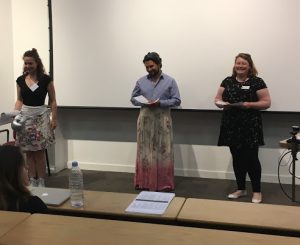A guest post by Becki Turtill
The Interruption was a project designed to explore the potential reasons for the failure of the Knight of the Burning Pestle when it was originally performed in 1607. Critics such as Joshua Smith, Brent Whitted and Liesl Rowe have speculated that there are a combination of reasons for the play’s flop: the first was due to the audiences’ interpretation of the satire imbedded within the dialogue; the second was the social composition of the audience. While these reasons are valid in themselves, these critics tended to pass over the performance context in favour of the language of the play, and as a result, focused upon the implication of the audiences’ interpretation of the satiric nature of the play as the main cause of its failure. The Interruption project became a response to this interpretation. Through performance, I explored the idea that it was both the unexpected and unwanted audience interaction, as well as the crossing of the social classes, that caused irritation leading to the negative interpretation of the satiric language. Due to the lack of evidence of audience responses to the original performance, I decided to modernise the induction scene to explore the uncomfortable nature of the first performance, allowing me to determine the audiences’ emotional response under similar circumstances.

Francisca Stangel, Jon-Mark Grussenmeyer, and Becki Turtill, ready to have their scene from Othello interrupted.
I selected a group of students to enact this modern reconstruction in front of an unsuspecting audience at the Medieval and Early Modern Summer Festival at Kent, under the guise of a workshop exploring the performance of the feminine in Shakespeare’s Othello. The students’ task was to interrupt Dr Clare Wright’s introduction to the workshop and voice their disapproval of her ideas, before taking over the session completely with the aim of performing something that ‘wasn’t Shakespeare’. This allowed for a destabilisation of the expected structure of the workshop, reflecting the subversive nature of the Citizen’s disruption of the opening scene at the Blackfriars. While there was a script to guide the students to their end goal, I placed greater importance on improvised performance. The actors could better respond to the audiences’ reactions while making the performance appear more realistic, which I hoped would emphasise a tension potentially closer to that in the original audience.
Furthermore, by focusing upon stage directions over the script allowed the scene to closely resemble the original in its disruptive nature. For instance, in the 1613 quarto, the Wife and Rafe are described as speaking from “below” on their first appearance, so it has been assumed by critics that they are sitting amongst the audience with the Citizen from the beginning of the play. Consequently, I chose to have the students enter with and sit amongst the audience. The Wife’s question “Shall I come up, husband?” with the Citizen’s response “Ay, cunny” imply that upon his entrance the Citizen has made his way, uninvited onto the stage. As we were unable to have any audience members in the staging area, like the original gallants, we chose to have the students remain in their seats until about half way through the performance, where they would cross the audience/ performer boundary and break the expected etiquette of the workshop. This delayed response allowed the students to fully situate themselves as audience members, creating a greater shock on their interruption while adding to the awkwardness. Moreover, I added stage directions for the students to interact directly with those immediately around them, to reinforce an embarrassment in the audience, similar to what the gallants may have felt during their direct confrontations with the Citizen― “Pray, gentlemen, make her a little room. I pray you, sir, lend/ me your hand to help up my wife.” ― and the Wife’s direct speech to them― “By your leave, gentlemen all…”.
After the performance, I explained the experiment to the audience and asked them to separate into groups and discuss their response. Many of the audience members reported feeling uncomfortable, stressed and embarrassed, both at their proximity to the disruptive students and on behalf of Clare in her attempt to control the situation. One person expressed how they felt particularly uncomfortable as Clare had been interrupted by a male student during a workshop intending to focus upon femininity, believing him to be undermining her based on her gender. This allowed me to ask further questions about the social hierarchy of the original performers. As The Knight was first presented by the Children of the King’s Revels, it has been suggested that the Citizen would have been performed by an older boy, while the prologue would have been a younger child. This may have presented the character of the Citizen as unintentionally threatening and added to a general dislike of the character. In addition, some members of our audience who were already familiar with The Knight noted they felt a sense of superiority when they realised the point of the performance before their peers.
The performance opened up further questions as to why the play may have failed. For instance, would there have been a sense of excitement at the disruption? Would there have been a sense of superiority among those in the 1607 audience members who did ‘clock-on’ quicker than their peers? Overall, while The Interruption can only allow us to speculate at the reaction of the audience in the Blackfriars, it opens the door to a number of questions surrounding its failure. It shows the potential of modern reconstructions to explore reactions to Elizabethan and Jacobean plays and allows us as academics to reflect on how timeless our emotions are.